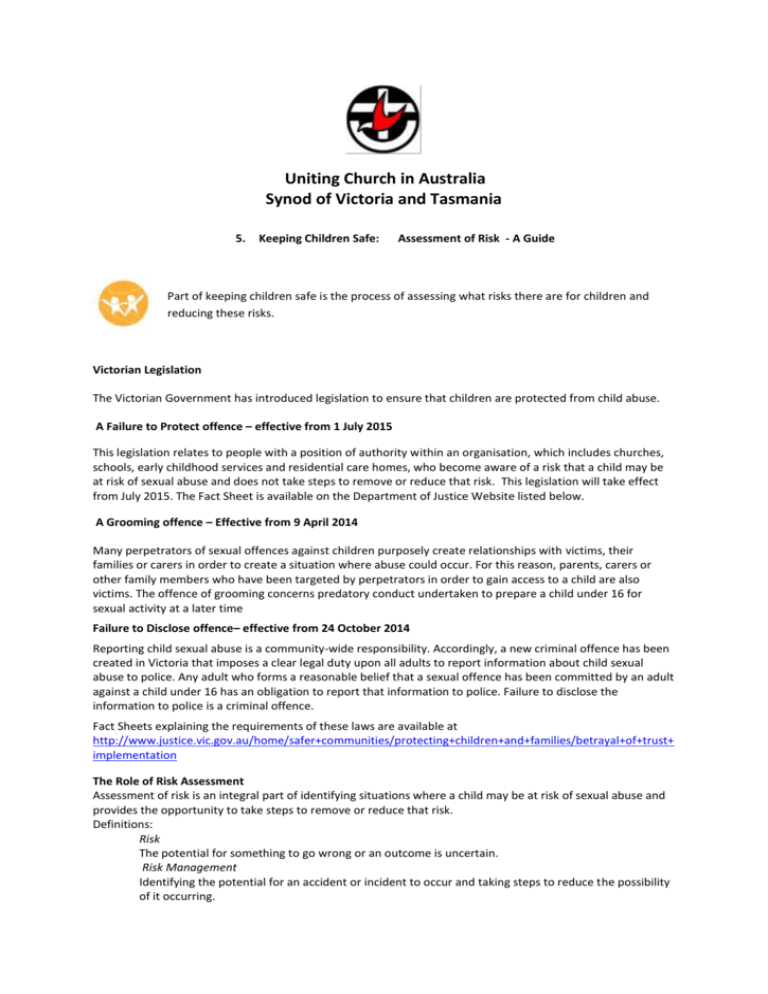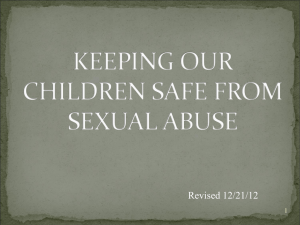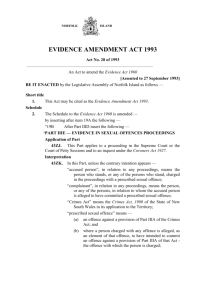
Uniting Church in Australia
Synod of Victoria and Tasmania
5.
Keeping Children Safe:
Assessment of Risk - A Guide
Part of keeping children safe is the process of assessing what risks there are for children and
reducing these risks.
Victorian Legislation
The Victorian Government has introduced legislation to ensure that children are protected from child abuse.
A Failure to Protect offence – effective from 1 July 2015
This legislation relates to people with a position of authority within an organisation, which includes churches,
schools, early childhood services and residential care homes, who become aware of a risk that a child may be
at risk of sexual abuse and does not take steps to remove or reduce that risk. This legislation will take effect
from July 2015. The Fact Sheet is available on the Department of Justice Website listed below.
A Grooming offence – Effective from 9 April 2014
Many perpetrators of sexual offences against children purposely create relationships with victims, their
families or carers in order to create a situation where abuse could occur. For this reason, parents, carers or
other family members who have been targeted by perpetrators in order to gain access to a child are also
victims. The offence of grooming concerns predatory conduct undertaken to prepare a child under 16 for
sexual activity at a later time
Failure to Disclose offence– effective from 24 October 2014
Reporting child sexual abuse is a community-wide responsibility. Accordingly, a new criminal offence has been
created in Victoria that imposes a clear legal duty upon all adults to report information about child sexual
abuse to police. Any adult who forms a reasonable belief that a sexual offence has been committed by an adult
against a child under 16 has an obligation to report that information to police. Failure to disclose the
information to police is a criminal offence.
Fact Sheets explaining the requirements of these laws are available at
http://www.justice.vic.gov.au/home/safer+communities/protecting+children+and+families/betrayal+of+trust+
implementation
The Role of Risk Assessment
Assessment of risk is an integral part of identifying situations where a child may be at risk of sexual abuse and
provides the opportunity to take steps to remove or reduce that risk.
Definitions:
Risk
The potential for something to go wrong or an outcome is uncertain.
Risk Management
Identifying the potential for an accident or incident to occur and taking steps to reduce the possibility
of it occurring.
EXAMPLES
We acknowledge that some entities of the Uniting Church including congregations, schools and agencies have
existing processes in relation to risk assessment. The examples below are offered to assist the development of
appropriate processes if there is nothing currently in place, or if what is in place is not suitable in light of this
template.
EXAMPLE ONE: ASSESSING THE RISKS IN YOUR ACTIVITIES FOR CHILDREN
A child protection risk assessment considers the likelihood of harm or abuse occurring to a child involved in a
service or program and focus on developing strategies to minimize and manage the risk.
1.
We will consider each potential child protection risk with regard to the likelihood of the risk occurring
against the impact of the risk. Those risks that are considered to be unacceptable are minimized
through the development of management strategies. Consider any risk factors in your program or
activity taking into account:
2.
The age/vulnerability/special needs of the children. The setting or environment. is it open, one on
one, at night?
The level of the adult/child ratio and supervision of children.
Previous incidents at similar programs and activities.
Any other risk factor you can identify.
Consider the following questions:
How likely is it that this risk will occur?
What are the consequences if this risk occurs?
Make a list of the risks according to how important each of the risks are?
Decide what you are going to do to make sure the risk is as low as possible.
If there are activities that have an unacceptable level of risk they may need to be reviewed or
cancelled by the person responsible for these activities.
Then:
Below is a hypothetical scenario of assessing the risks of an activity in a congregational setting.
Mitchelton congregation is holding a Christmas Carol evening. Whilst the congregation does not have
children regularly attending services, the Church Council has been told by more than one
congregation member that they will be bringing their grandchildren to the Christmas Carols.
Bev, the chairperson of the Church Council recognises that it is important to assess any risks of harm
that could come to the children at the Christmas Carols. She talks to the Church Council about this.
As a group, the Church Council identify that the children will be in an open space at night. Although
they will generally be under the supervision of their grandparents, it is possible that the children will
be running around the church premises unsupervised, particularly before the carols start.
The Church Council assesses the risks of children coming to any harm as ‘possible’ but the
consequences if it does happen as ‘serious’. They decide to appoint Hugh, a member of the
congregation who holds a Working with Children Check, to supervise the children before the carols
start. Grandparents will be informed of this when they arrive.
EXAMPLE TWO: CONDUCTING A REGULAR SCHEDULED RISK ASSESSMENT
We recognise there are potential risks to children and will take a risk management approach by undertaking
the following preventative measures:
Proactively identifying, assessing, managing and reviewing risks to children in programs/projects
undertaken by our entity.
Conducting regular checks throughout the program/project cycle.
Proactively identifying, assessing, managing and reviewing risks to children in internal systems and
procedures, by asking:
o
o
o
o
o
o
What/how/why children might be abused?
What are the dangers?
What could go wrong?
What are the consequences?
How likely are they to occur?
What controls such as policies, procedures and strategies are, or should be, in place?
Implementing new preventative measures when gaps are identified.
Build in regular review periods to ensure that changes which may have occurred have been
incorporated into the risk management process.
Communicate and consult with all people involved in the program to ensure they are given an
opportunity to:
o
o
o
o
Participate in discussions and decisions.
Be informed about what decisions have been made, and why.
Have access to copies of policies statements and procedure manuals.
Provide feedback, which will be taken into account immediately where necessary or when
undertaking a regular review.
This template is to assist with the implementation of the Keeping Children Safe Policy of the Synod of Victoria
and Tasmania, adopted by the Synod Standing Committee on 24 June 2015. Templates will be updated from
time to time. If you are using a printed or saved copy please check the website for the latest update.
The policy and templates are available from www.victas.uca.org.au/keepingchildrensafe
Updated 3rd December 2015












